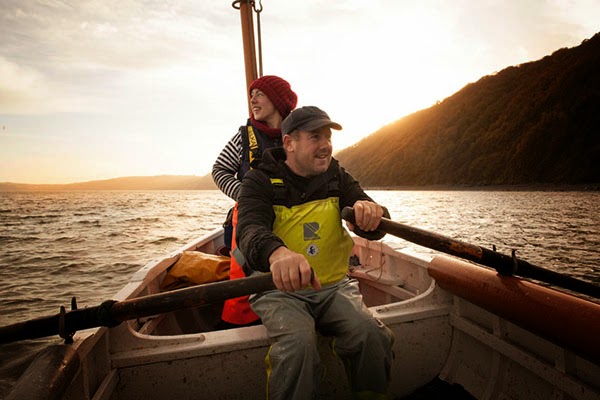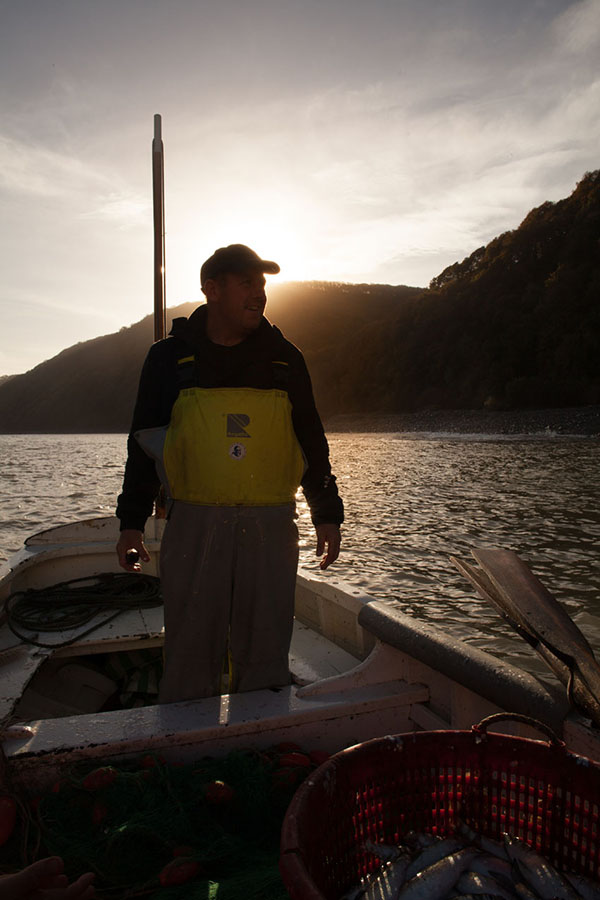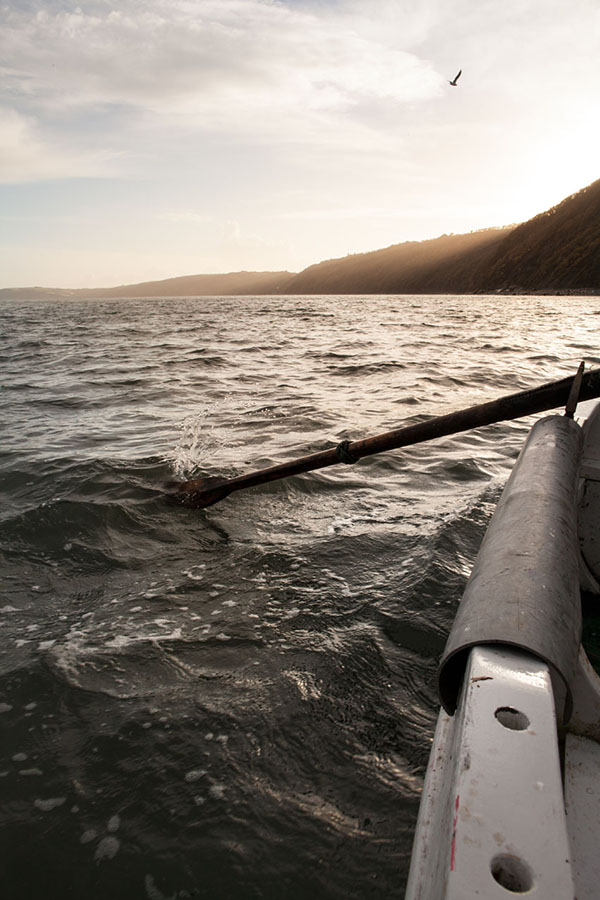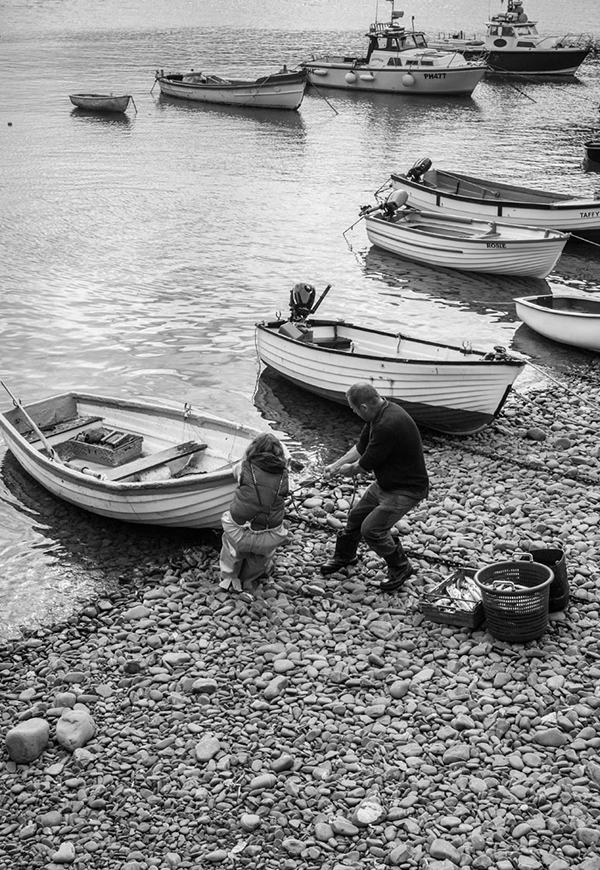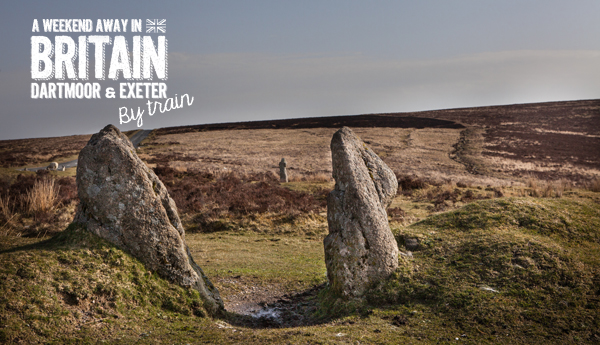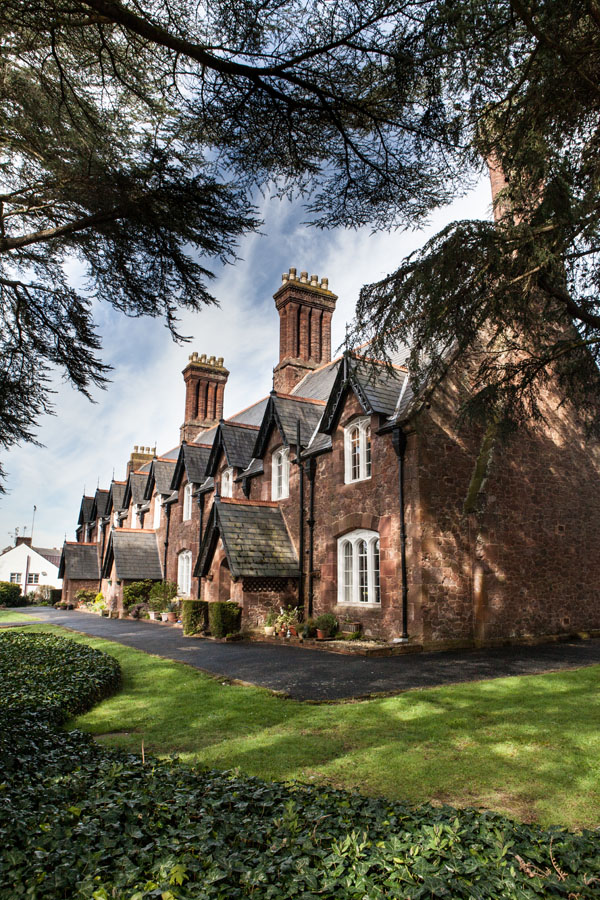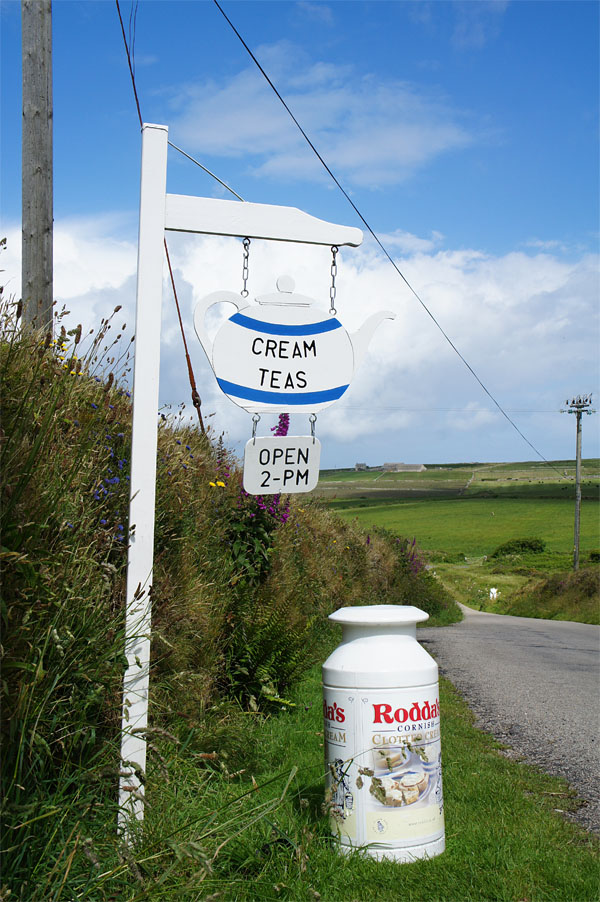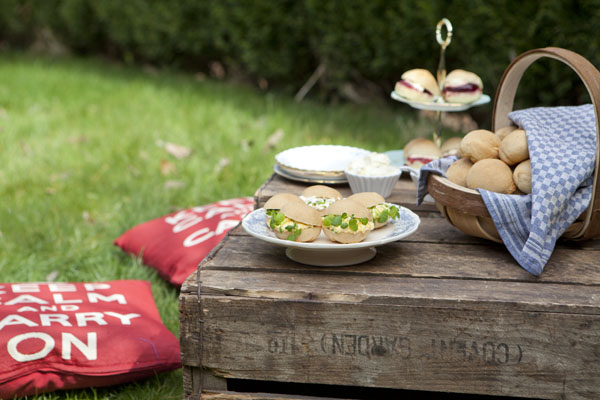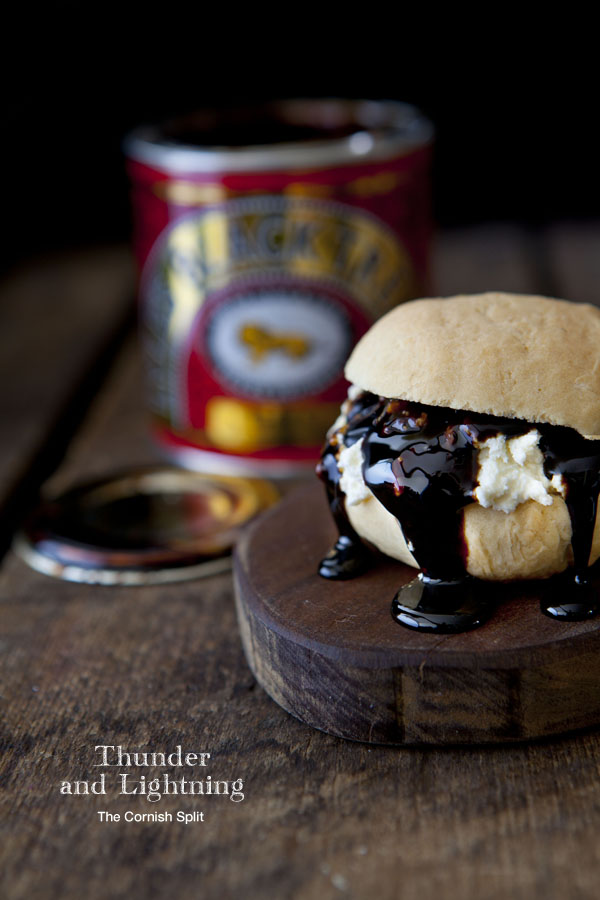The post The last of the herring men appeared first on Miss Foodwise.
]]>
In November I visited my friend Stephen Perham, the last of the Clovelly Herring men.
Also the Clovelly Harbourmaster, he is the only fisherman still living in the village and the only one who sells his catch. One of the very few others is Tommy who is Stephen’s brother, but he doesn’t live in the village anymore.
He is the last of the herring men of Clovelly, the last link between the old and the new; he is the one who keeps all those long lost souls alive, the keeper of hundreds of years of memories.Even when visiting the local pub in Clovelly, we find a lingering echo of Stephen and Tommy’s ancestors. The pictures on the wall of the snug bar tell the story of a Clovelly long gone, of fishermen gathering around the table smoking pipes and pictures of the most beloved wooden boats, of which only a few still remain in the harbour. These boats are unique to Clovelly and built to get out to sea faster than the larger boats when the herring arrives.
| Stephen in his Picarooner, a wooden boat unique to Clovelly |
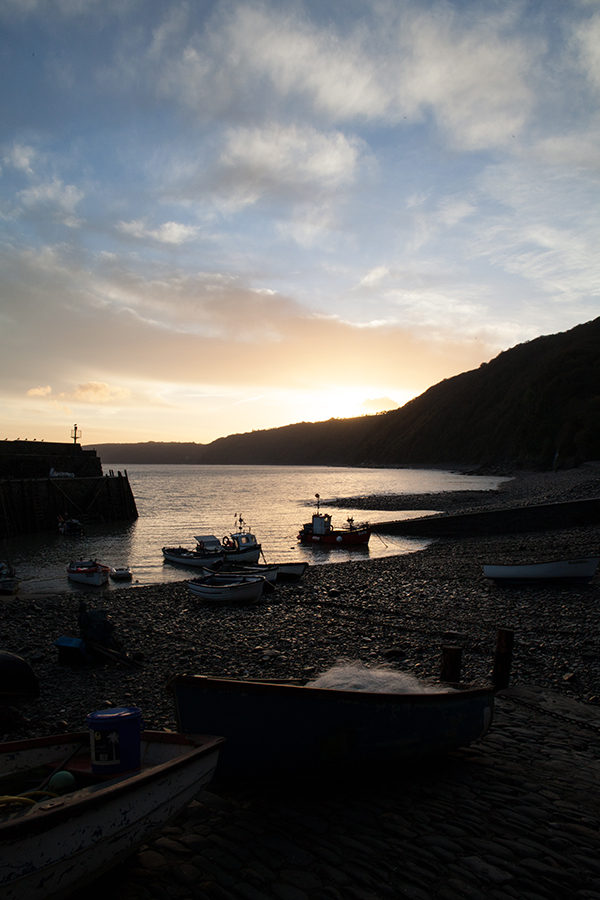 |
| The harbour at dawn |
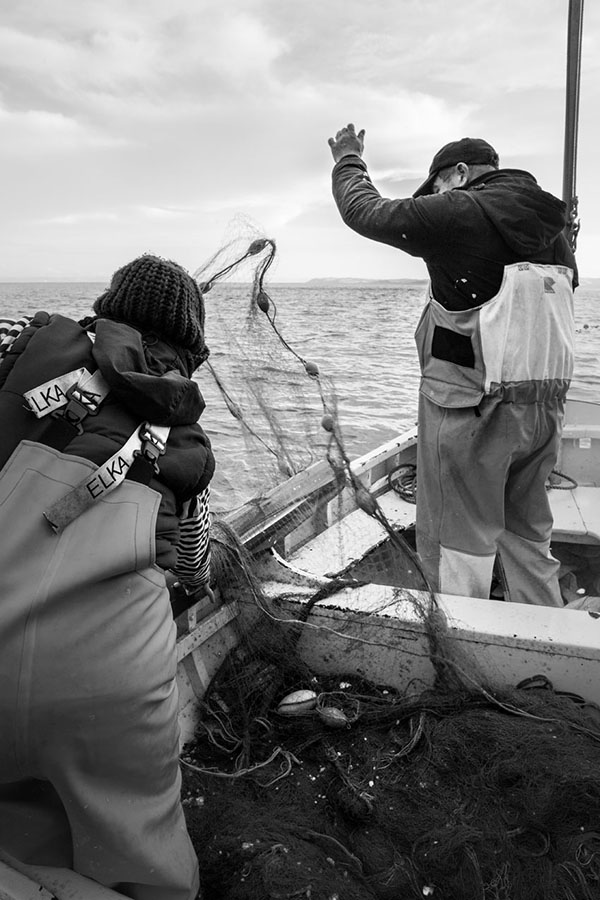 |
| Traditional sustainable fishing methods that haven’t changed for centuries |
Clovelly as a community, like many other similar coastal villages, once depended on the herring trade. Records show that two hundred years ago there were a hundred herring boats in the harbour with amounts around nine thousand herrings or ‘Silver Darlings’ brought in from sea. The days of the large herring fleet are long gone and today there are just a few fishermen who still go out for the herring, using sustainable fishing methods with drift nets.
Meeting Stephen, you immediately understand why the town’s herring festival each november isn’t just another food festival – it is a celebration of tradition and heritage, his heritage. Stephen is a 6th generation Clovelly herring fisherman, and with him and his brother, sadly, the line is very likely to end.
This proud and gentle-natured fisherman is the essence of this little village; he and his family represent the past and the future. He knows all the stories – where which boat got shipwrecked and who survived or was lost to the sea. He can read the waves, the sky and the sound that the rain makes when it hits the water. Fishing is in his blood, and fishing for herring is his passion as it has been associated with his family and this little village for centuries. As harbourmaster and the last full-time fisherman in the village, he knows where every boat is at any given moment and, although it is hard to sell herring these days -it is now a fish which is unjustifiably out of fashion- he continues to go out for herring because it is what he genuinely loves to do.
Life by the sea was so different in the old days; nearly all the men in the village were employed in herring fishing up until the 20th century. In the past, fishermen had to move away from their beloved little coastal town with its steep hills and cobbled lanes during the summer when there was no herring to be caught. They would work on the Royal Yachts further away but by the time the herring returned to these pebbled shores they would be home. The season of the Silver Darling runs from Michaelmas to Christmas and that’s why for Stephen “herring means Christmas”. It’s the build-up to Christmas, his favourite time of the year. He says once you get to Christmas it is all about the food, the puddings and the cakes. This fisherman loves to cook.
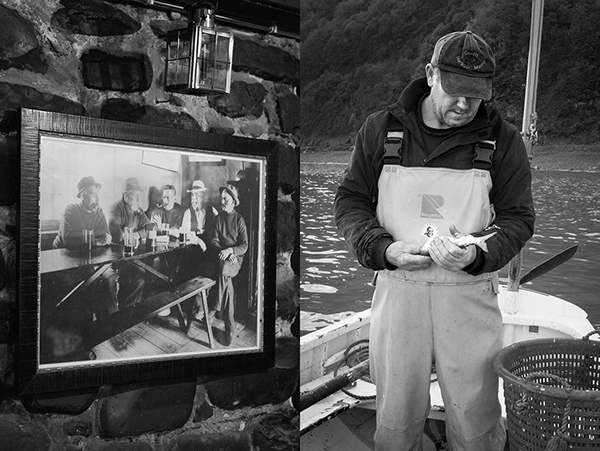 |
| Right: Stephen and Tommy’s ancestors on the wall of the village pub |
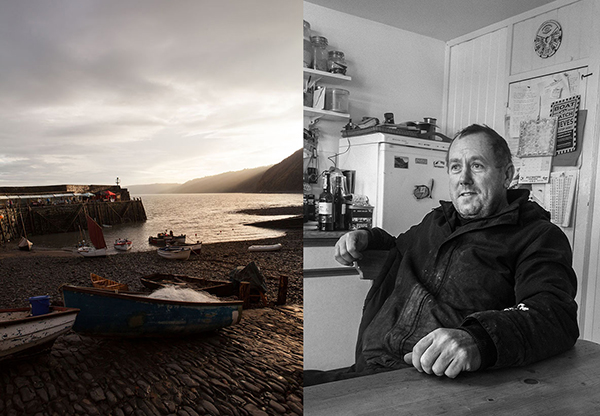 |
| Stephen looking out over the harbour from his kitchen, nothing happens without him knowing about it |
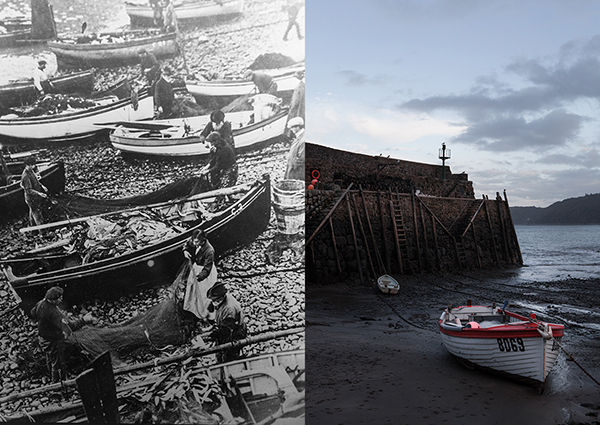 |
| Left: The large herring fleet of the past. Right: One of the last of the fleet today. |
His passion for herring and the traditional methods of catching them made him think about how he could try and put herring back on the map. The Clovelly Herring Festival was originally the brainchild of Stephen, Bob Rouse and Sue Haworth, who both work for Clovelly Estate, and the author of the well acclaimed book about the history of herring fishing, Mike Smylie. Smylie, as a maritime historian, has done a great deal for the fishing industry, and the herring industry in particular, trying to record the traditions of a dying industry that for years had fed the nation. He and Stephen met when BBC Radio 4 introduced the two in a program about Smylie’s herring book and they have been friends ever since.
Mike Smylie comes down to the Herring Festival each year with his self-made herring smoker, which looks like an old outdoor loo. He believes that people went off smoked herring due to the usage of artificial dyes to speed up the smoking process of kippers during WW2. It is also a rather sad fact that people have become so used to buying ready filleted fish that they have lost the knowledge of either boning a fish or even just eating it straight from a hot pan from the bone. Herring contains a larger bone and tiny little long bones which you can actually just eat. These little harmless bones had provided the people with much needed extra calcium in the past.
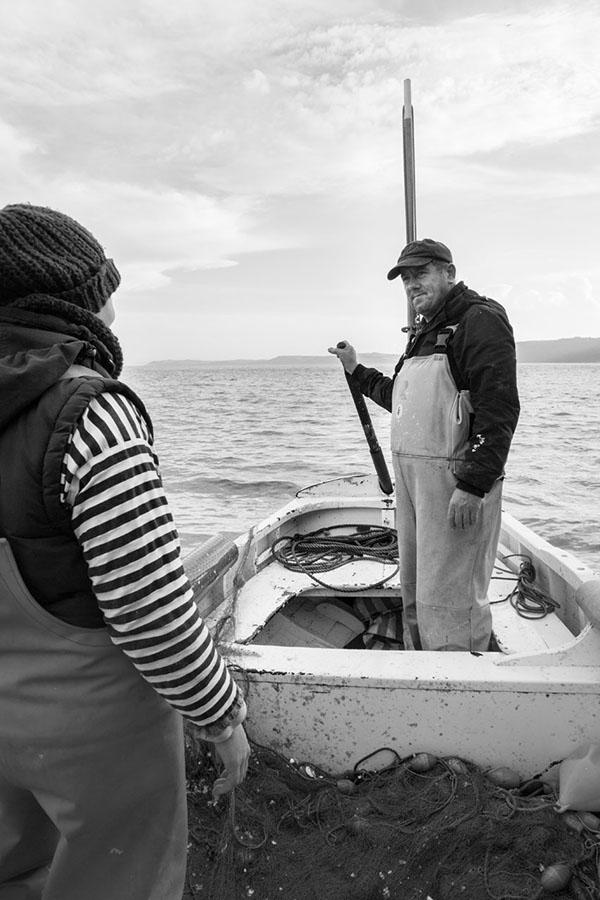 |
| Joy goes out to sea with Stephen whenever she can. |
Herring was plentiful until stocks collapsed in the 1970s. Smoking herring into kippers or salting it down in barrels, either for bait or consumption, had always been the most common way the herring was processed. That way it could be kept for longer and transported further inland. As herring was a main food source it became a staple during the war. The ‘herring ban’ in 1976 caused the closure of the Celtic and the North Sea fisheries and it lasted until 1983.
Stephen Perham and his brother Tommy were growing up during the herring ban and his father taught them the ropes of the trade by drawing diagrams in the salt of the windows of his house. Unfortunately their father died a year before the ban was lifted, but Stephen has been fishing for herring ever since.
The extraordinary thing about Stephen’s method of fishing is that it hasn’t changed one bit from how his ancestors did it. The boat is still the same type of small 16 ft wooden ’Picarooner’ his forebears used, nicely painted white every year and finished off with a pretty red rim. The nets are also still the same design, although they are now made of nylon rather than cotton. The only thing that has really changed is the demand for this beautiful silver fish. The big markets like Brixham and Plymouth just aren’t interested in herring any more.
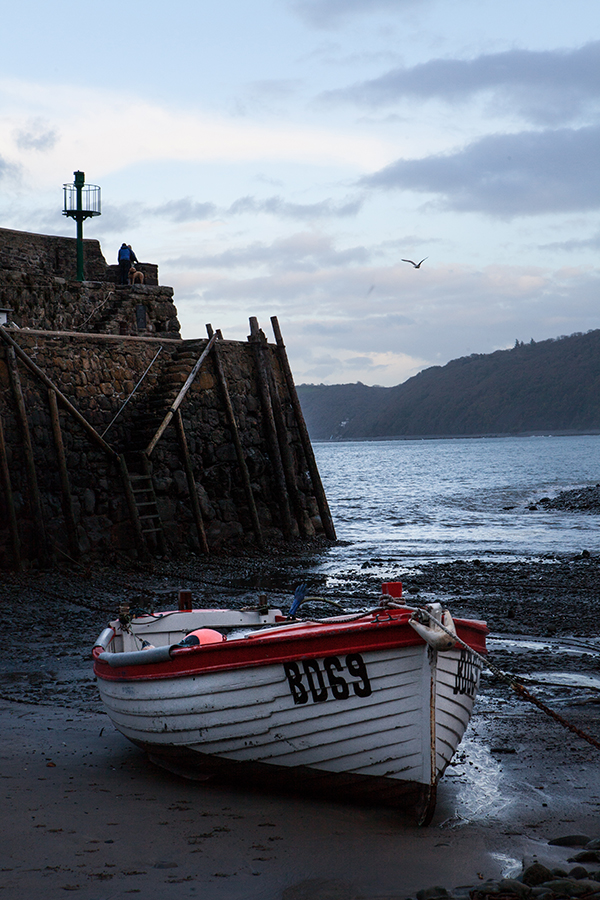 |
| A lonely ‘Picarooner’, a wooden herring boat unique to Clovelly |
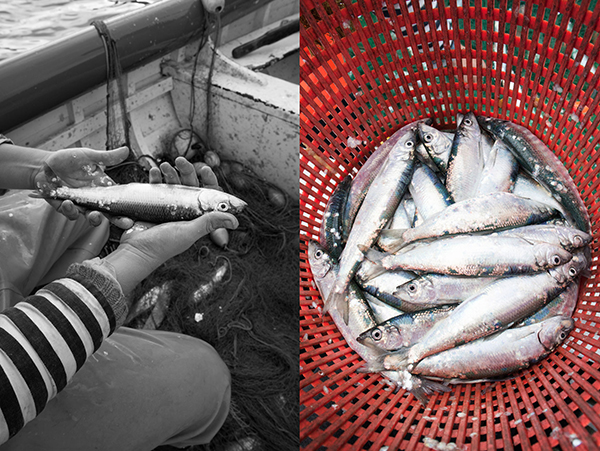 |
| It’s not difficult to see why these shiny fish are nicknamed ‘The Silver Darling’ |
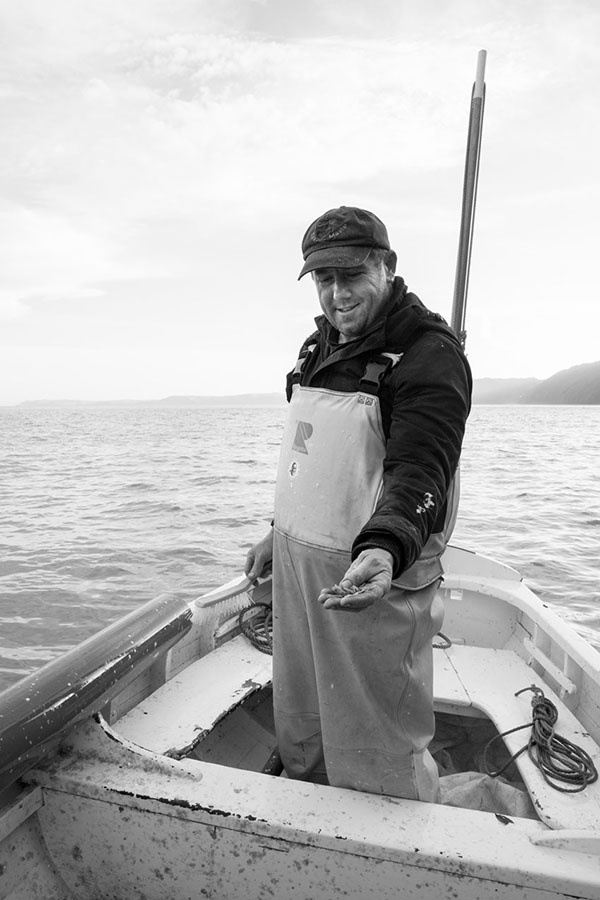 |
| Stephen shows me that the herring scales are everywhere. The boat looks like it is embellished. |
Luckily a food festival, like the Herring Festival in Clovelly, puts a healthy, oily fish like herring back in the spotlight and onto the menu. Not only does the food festival offer a number of stalls selling herring delights traditional and more exotic, there is fresh herring to take home, and there are also several stalls selling other local produce. I was on hand this year to help Stephen and Joy sell their lobster rolls, which we lovingly prepared that morning. Perham herring, which is how Stephen and Tommy call their beloved fish, was celebrated and enjoyed by many for this one whole day. But it should be on our plates more often.Rick Stein and Marco Pierre White have both come down to Clovelly in recent years to fight the corner of the herring. And it deserves saving. Clearly herring is a versatile fish; it is gorgeous fresh, but just as good smoked into kippers, simply baked in plenty of butter or cured into rollmops. A fish abundant and healthy, we should eat it more to support small scale fishermen who catch these little fish in a sustainable way and support carefully managed fishing. But, foremost, we should eat this fish because it is good for us.
If there is one thing I’ve learnt on my few days with Stephen and Joy, it is the importance of heritage. Traditional sustainable herring fishing is under threat to be lost. Fishermen have difficulties to sell their catch so have to try and find other ways to sustain themselves and their families, or move away from their villages and learn a different trade. Their quaint fishermen’s cottages are turned into holiday homes and their boats into flower beds. But Stephen is sure he isn’t the only one who’s at the end of a line of fishermen, there are other fishermen in other coastal villages who are also trying to hang on to a small scale sustainable method of fishing. His dream is to take to sea with the small wooden boat, he lovingly named ‘Little Lilly’ and visit those other fishermen, and write down their stories like I am writing down his today. For Stephen it is important that these old traditional methods, and the names of those who keep it alive, are noted down somewhere, so that they aren’t forgotten and lost. So that their heritage doesn’t rot away, like the old boats do on the beaches all round the British coast.
I hope that Stephen can sell enough of his catch to go on his trip. Because it is an important work to write, and one I would love to read.
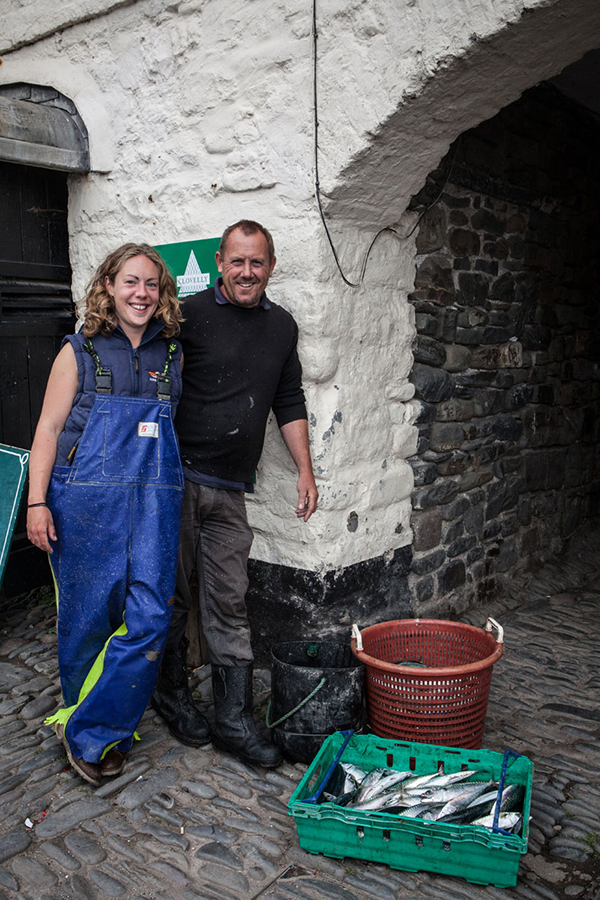 |
| Joy and Stephen when I first met them two years ago in the summer, with their catch of mackerel |
When I was visiting them my friend Sassy and I also shot a little video when we went fishing for herring with them. I hope you’ll like it!
I’ve uploaded it to my new Youtube Channel, don’t forget to subscribe 
The post The last of the herring men appeared first on Miss Foodwise.
]]>The post A weekend away in Britain: Dartmoor and Exeter by train appeared first on Miss Foodwise.
]]>Ditch the car for a long weekend
This online space of mine has always been about my love for Britain, not only British food. Traveling around the country, exploring regional dishes, wandering around small villages and heritage sites is what I love to do most.
So what would I do on this long weekend ahead of us? I would venture out to Dartmoor, the weather is going to be splendid for walking and having a lovely pub lunch outside. And what if you’re stuck in traffic with your car every day, or don’t have a car, don’t know how to drive or just want to get away without your car, just because you want to.
This is a weekend away to Dartmoor and Exeter, without a car, but with plenty of fun.
Day 1: A dinner on a train to Devon
The weekend starts on a friday evening at Padding station in London, we’ve already spent the day in London browsing book shops and munching our way through Borough Market but the real trip is starting when the train to Devon leaves the platform this evening.
We have a booking on the First Great Western Pullman service, which will wine and dine us until we arrive in Exeter. They journey should have brought us to Cornwall but nature took over in the West Country a couple of weeks ago and the train track at Dawlish got consumed by the sea. Our plans had to change so we decided on a weekend of walking and pub meals in Dartmoor.
I’ve always had a thing for dining trains, it just oozes Victorian charm and I can just imagine how it used to be on the older and more charming train carriages. We board the train around six and as dinner service is shorter temporary, we are taking our place at our table while we leave the station. It’s a full house, or should I say full train to Exeter and dinner service commences with a quick pace. The team on board serving us is professional and witty, it is clear that we have some regulars dining with us today. I heard the Somerset steak has a good reputation so I had to try it and for my starter I chose the Dartmouth salmon with Blackmore Vale Dairy cream cheese. That’s the thing with this Pullman dining service, they have sourced the produce from the land and the waters we are travelling past on the train. The menu has been created by Mitch Tonks of the Seahorse in Dartmouth, as is the wine list which is sadly lacking a British wine. I sipped my pint of Tribute when we were approaching Reading, the salmon was delicate in flavour and the cheese a definitely good match, the steak really was devine and cooked medium rare as I asked. The sun was setting and a short while before Taunton we received our dessert, a cheese platter for us as we don’t have a sweet tooth. All British cheeses which were at the right temperature, a soft Helford white, a smoky Devon Blue and a Keens Cheddar served with a quince jelly that was so good I finished Bruno’s as well.
By the time we left Taunton, we were full and happy and ready to turn in for the night at our hotel in Exeter.
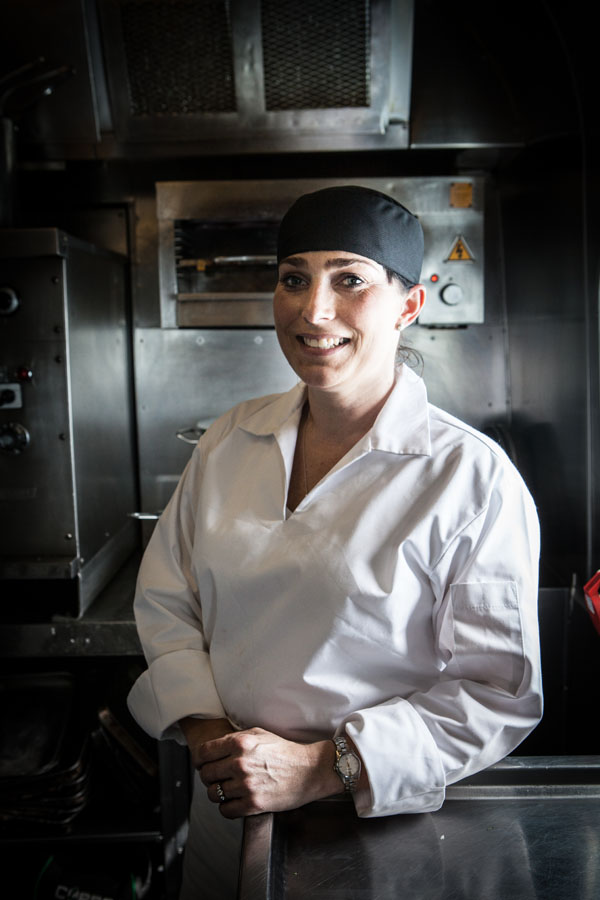 |
| The lady chef of the Pullman dinner service |
We were so tired after walking around London all day and enjoying such lovely food on the train, that we had an early night, ready to take the twelve O clock bus to Dartmoor.
Day two: To the Moors
Busses to Dartmoor leave from the coach station in Exeter, after a walk around town with our backpacks we made a quick stop at the Real Food Store for a piece of cake – which was moist and full of dark chocolate and left us pining for more. The bus trip to Moretonhampstead is about an hour and with plenty of pretty views along the way and locals having a chat with you, it is over and done with in no time. We arrive in Moretonhampstead and start the search for our 13th century farmhouse B&B.
The farmhouse is situated a 20 minute walk out of the village, it’s a nice scenic walk and as the weather was so warm for the time of the year, we enjoyed it.
As I had seen on the website, the farmhouse was gorgeous. It is a gem, and unspoiled treasure. If you like flowery wallpaper and curtains like I do, this is your B&B. No modern additions except for the bathroom which makes this stay all the more relaxing. The sun tries to enter the room through the bay window in our room and we both make it ourselves cosy and comfortable in the armchairs which have a warm woolen upholstery. No rest for the wicked, after less than an hour we are out the door again, this time with bikes we conveniently rented from the B&B. We drove back to Moretonhampstead with a hungry tummy and thirst for a local ale. After a visit to the local butcher for a pork pie and to the greengrocer across the street for apples, we were ready for a picnic with friends we know in the area. It was my birthday, and although we planned to do some walking that day, we just had too much fun outside in the sun, savouring Devon delights and catching up with friends.
Dinner was booked at the White Heart and as we were with the bikes we opted to eat early at six. The food was great and quite fine for a pub, the pudding sticky and sweet and the ale local. A good evening and day all round and we start our return trip to the farmhouse in pitch black. I must admit I was scared at times, my imagination always gets the better of me and soon I was seeing the hound of the Baskerville in the light of my cell phone. Street lighting is none existing so take a torch with you, we didn’t.
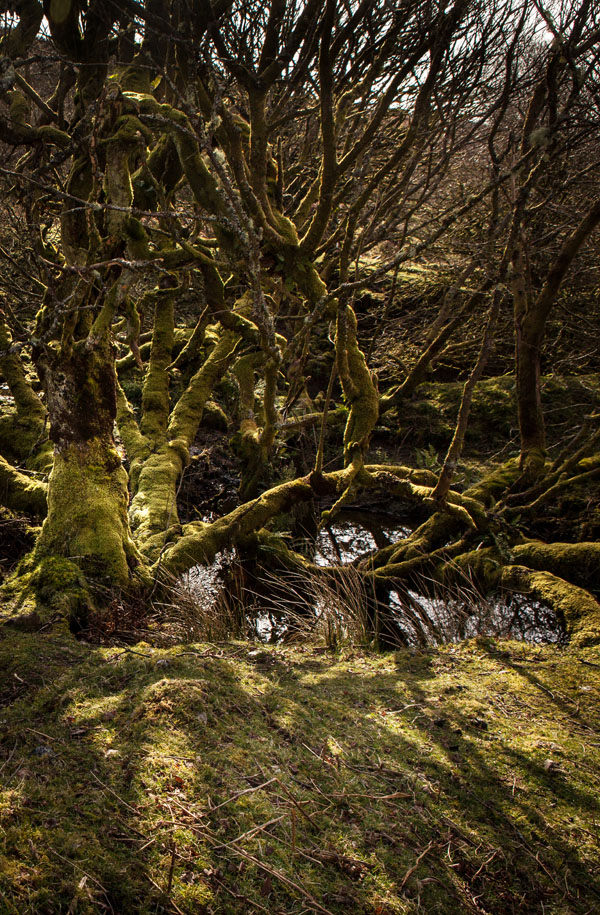 |
| The moss, very Tim Burton |
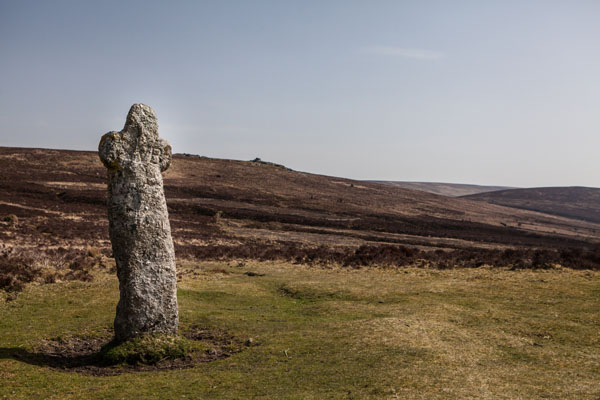 |
| The shivering cross |
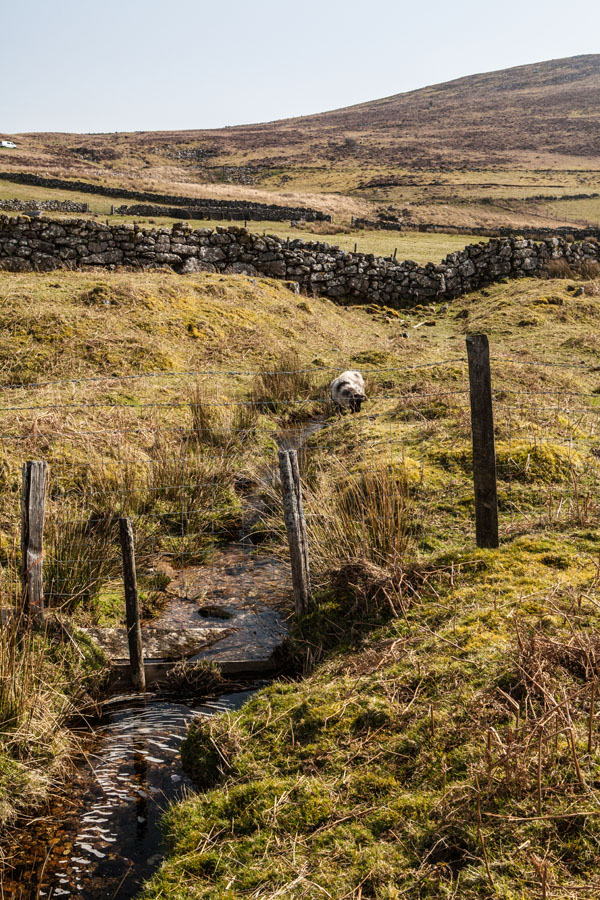 |
| A sheep |
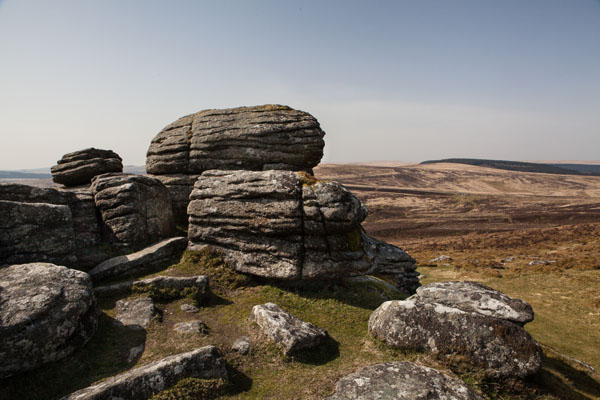 |
| A Tor |
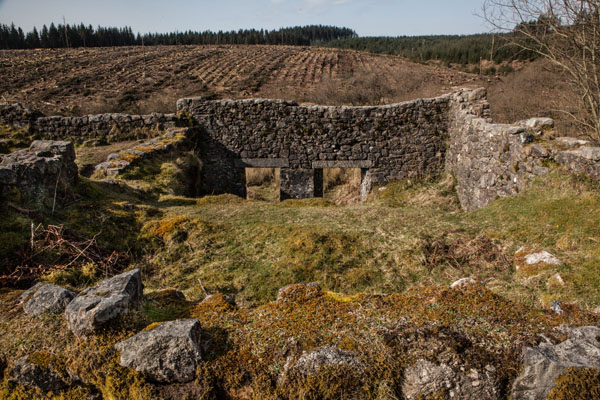 |
| The ruins of a house that was still a home 50 years ago |
Day three: big fry up and fried shoes
The next morning we were woken by the song of birds and beams of sunlight peeping through our flower print curtains. We had a full English in the quaint farmhouse breakfast room, which is full of vintage Staffordshire pottery and other kitchenalia. As was to be expected, the breakfast was fabulous with their own fresh eggs, local bacon, great sausages and freshly made yoghurt. All washed down with a nice cup of Earl Grey we put on our walking boots, and were greeted by the door in a ray of sunshine by Inga, our guide to Dartmoor today.
As we only had one full day on Dartmoor and we were without a car, we opted to do a guided walk with Inga. There are no extra busses that drive up the Moors, if you don’t have a car, you will not get there so Inga is catering for people who are on foot like we were. A few minutes drive with Inga brings us to the Moors and we embark on a eight or nine mile walk.
Soon it becomes clear that my boots, old army boots, have had their best years and are not waterproof. We are walking on a path that looks more like a stream of water, but as the scenery is so breathtaking, I just don’t mind the water getting in and get on with it.
I am happy we went on a walk with Inga as she not only knows where to go in this National Park that hates putting signs up for walkers, she also knows quite a few things about the history of the Moors.
The romantic rough rolling landscape of Dartmoor appears to be a wonder of nature but it is mankind who shaped the land for millennia. The people who lived and worked on Dartmoor for centuries have left their mark and pierced through the the hills to get to the precious tin. From as far back as the 12th century, tin miners created gullies to follow the veins of tin ore back into the hillside. You can still see where the large water wheels were positioned at the tin mills. The tin was rinsed from the stone and melted down. The mills have long gone, as are the wheels, just leaving behind deep wounds in the hills and small mounds of waste spoil of earlier digging works. When you look closely at the hills around Challacombe farm you can see a round circle of stones on the hillside. This is a bronze-age village called Grimspound. Around 3500 years ago the village was built by celtic settlers who grazed their stock out on the hills to take them in to the enclosure at night to keep them safe from the undomesticated wild animals like wolves, at night. From this settlement where all that remains are a few round circles where the round houses used to be, you can see burial mounds on Hameldown and a stone row that is believed to be badly ‘renovated’ by the Victorians. On the other side of the hill the side appears to have been terraced. They were probably created by Medieval farmers in a time when the climate in Dartmoor was much warmer and drier. They must have used the strip fields for growing cereal crops. We passed a large stone wall which Inga told us used to be a rabbit warren, as rabbits used to be farmed for their meat here, centuries ago. It reminds me of the Roman Hare gardens which declined after they left Britain.
If were would have been walking on our own, we wouldn’t have noticed quite a few things.
We passed at ruined farm which Inga told us was still a home 50 years ago, opposite the ruin we found remains of an old Diesel mill which was active during the war when resource were scarce. After the war it was closed and never re-opened. By the look of the ruins, there must have been a real community up on the Moors. Now there are only a handful of houses left, most of them working farms. The first written mention of people living in the area at Challacombe farm appeares in the Domesday Book and you can still see the remains of 7 medieval dwellings of which one Dartmoor Longhouse where animals and people shared the same building to keep warm.
According to Challacombe farm there were 5 tenements at Challacombe in 1613 and they were in use until 1880. One of the buildings was a cider house to serve the many miners and farmers working the land. In fact there used to be a lot of pubs on the Moors.
After four hours of walking and a welcome slice of lemon cake from our lovely guide Inga, we make our way back.
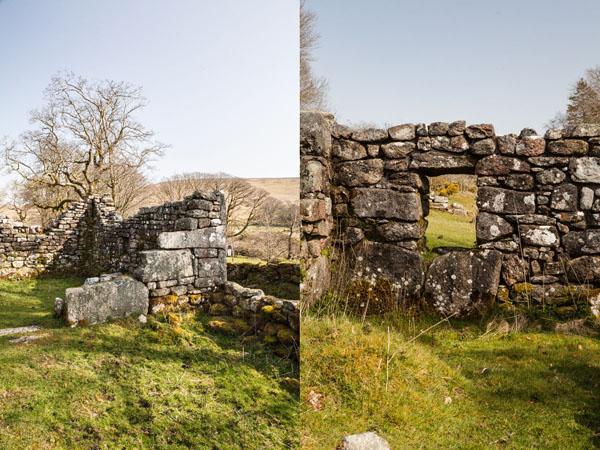 |
| Settlements from 1613, one of them a cider barn |
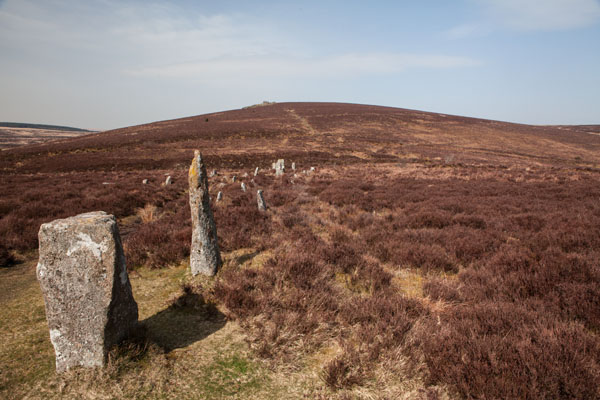 |
| Stonerow, renovated by the Victorians |
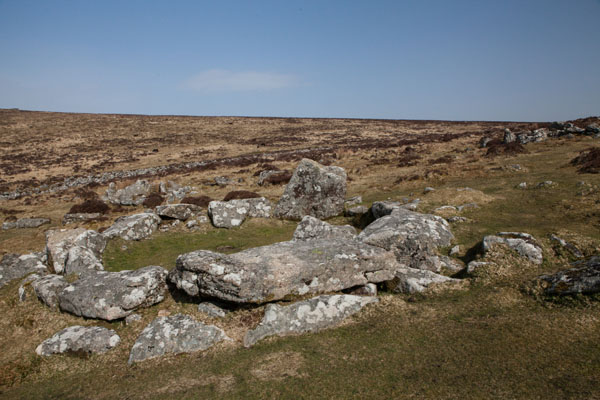 |
| Celtic round house |
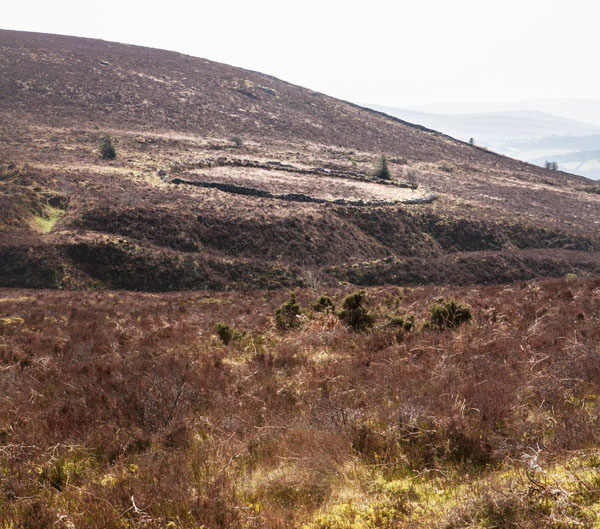 |
| The outer enclosure of the Celtic village |
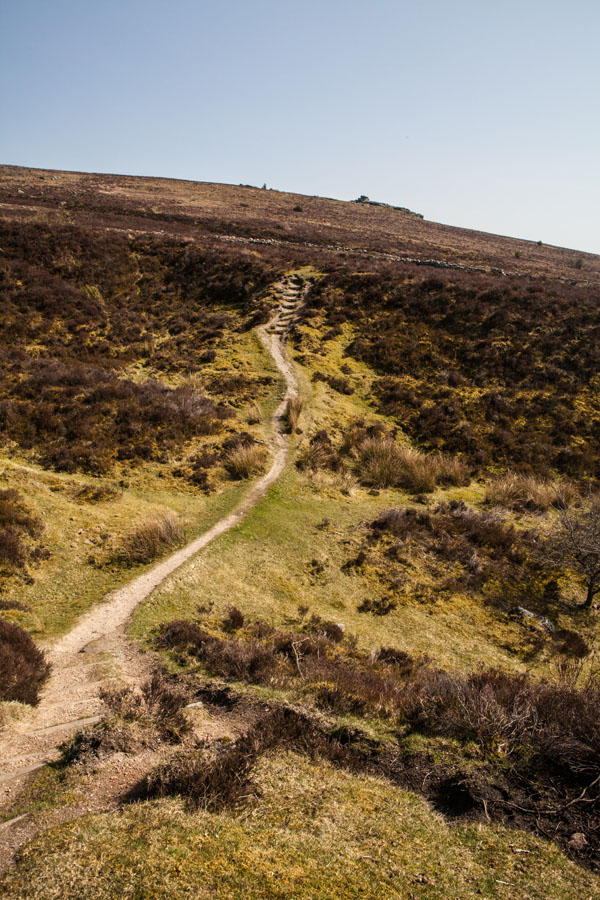 |
| a bit of stairs |
We skipped lunch as the sweet fresh air has left us without an appetite. We decided to do yet another walk to North Bovey, a quaint and quiet village not far from Moretonhampstead. After a stroll around the village, the appetites are now well and truly transformed into raging hunger and we walk into The Ring Of Bells where local ale and a pub meal awaits us. After dinner we decided not to walk back to our farmhouse B&B, as were were really only ready to put on our pyjamas and take a trip to dreamland. Ask the bartender to book the cab when you arrive as there is only one, yes only one car running as a cab on the Moors.
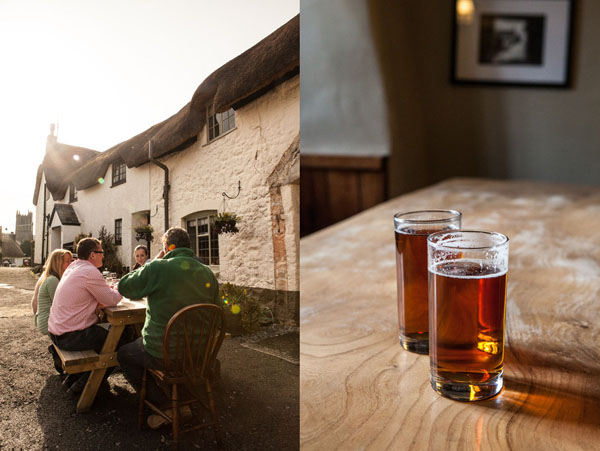 |
| The village people of North Bovey gathering at the pub |
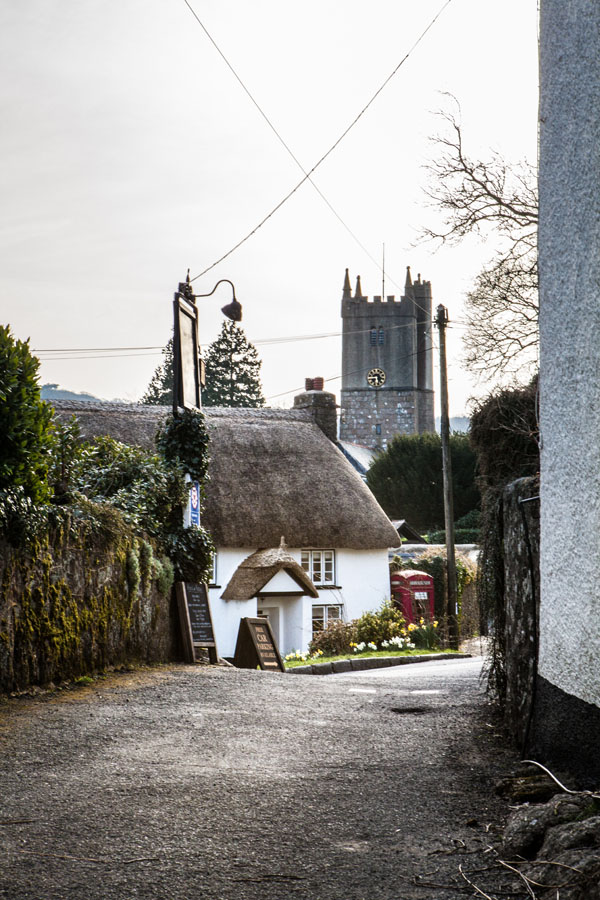 |
| North Bovey, seen from the pub |
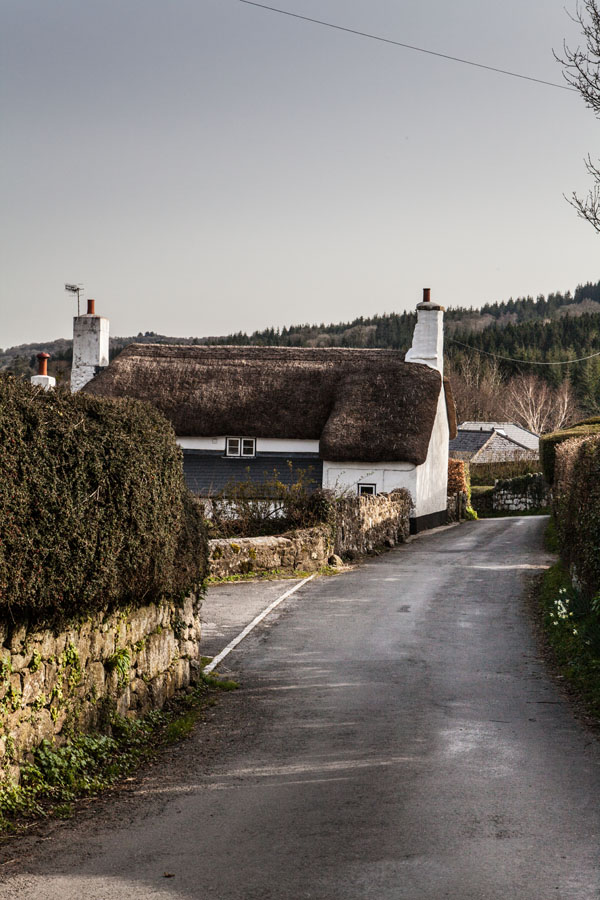 |
| Pretty village, North Bovey |
Day four: The farmhouse and the curious cattle
The next morning we enjoy our room for a few hours, reading a book and gazing out of the window after a filling breakfast. Before we leave for Exeter again, we go on a walk round the farmhouse and the farms Aberdeen Angus and South Devon cows. We walk back to Moreton, and have a little walk around town again before we take the twelve O clock bus back to Exeter.
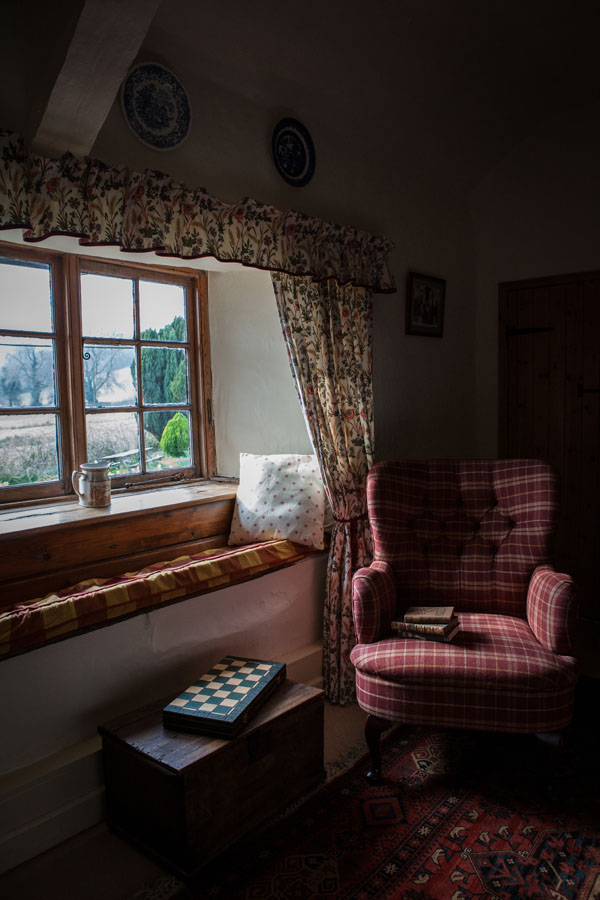 |
| My kind of nook |
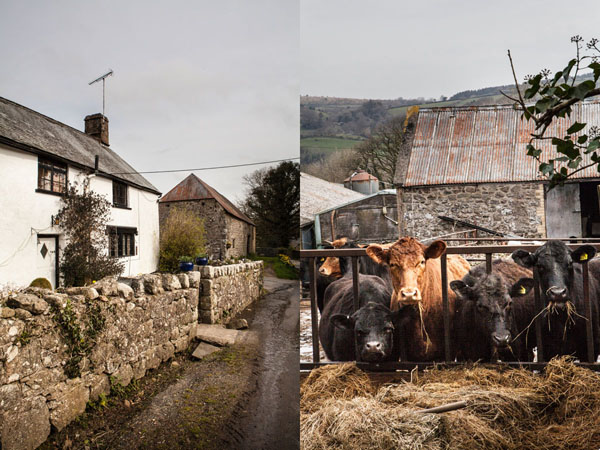 |
| The farmhouse and the curious cattle |
Exeter
Back in Exeter we do a bit of window-shopping and we head down Magdalene road where a few small local food stores are. A fish monger, a butchers and a green grocers in one street. The coffee shops and small eateries are just a bonus to that. We enjoy a welcome Devon cream tea at Tea on the Green at Cathedral Close which is conveniently located near to our hotel. While visiting a few independent shops on Fore street, we get a dinner recommendation from a local girl.
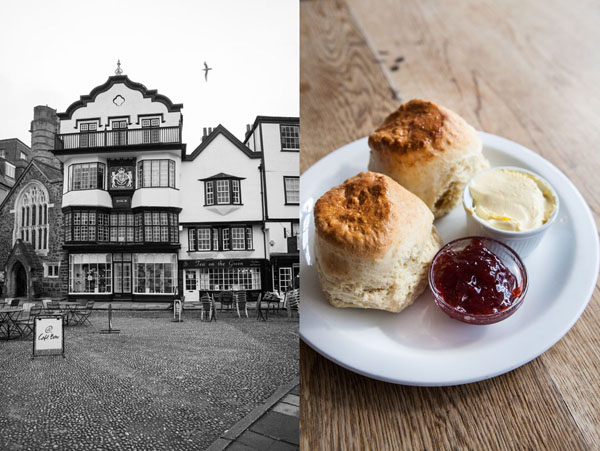 |
| Tea on the Green |
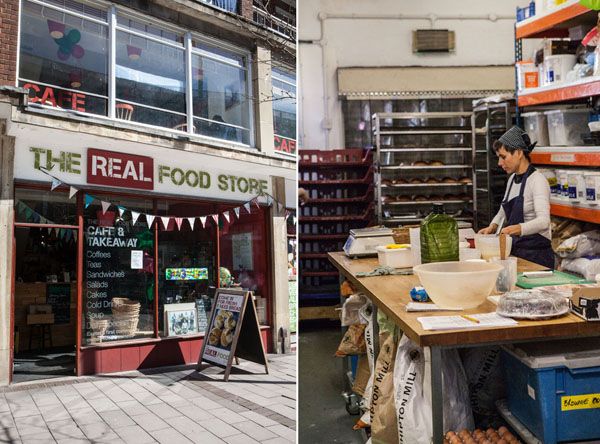 |
| The Real Food Store, good cake and freshly baked bread |
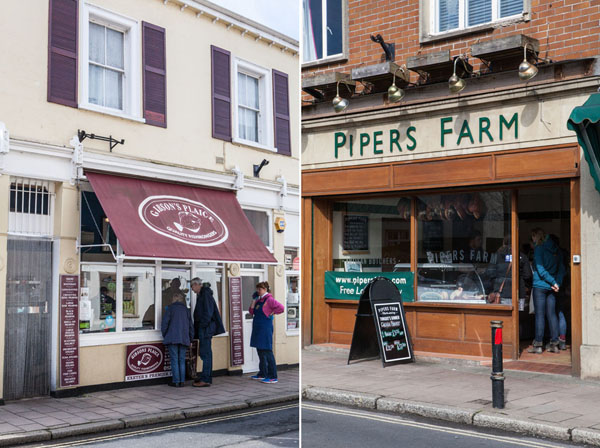 |
| A Butchers and a Fishmonger |
The Fat Pig it is for dinner. We are told it is quiz night but we are kinda curious to see the event so we stay anyway. The Fat Pig is a buzzing pub which has its own smokehouse and brewery. The food is great and the home-brews are very satisfactory, the pub quiz is so funny with questions about serial killers and music that we stay until the end and enjoy a Whisky or two after our food and beer. We can you see, because we don’t have a car with us.
Cheerful
we return to our hotel, which isn’t a thirteenth century farmhouse but
still very comfortable and located on Cathedral Close – close to Tea on
the Green where we decided to have breakfast the next morning.
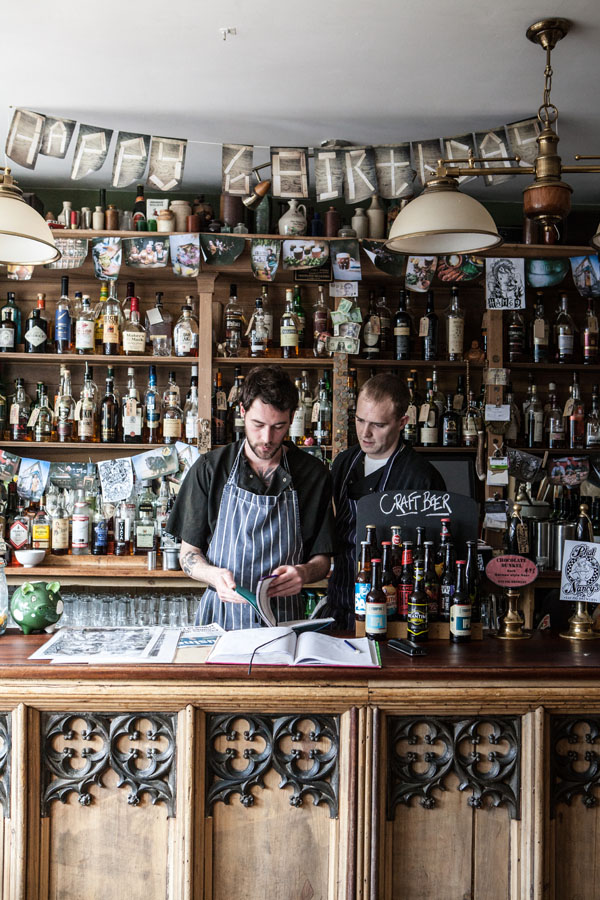 |
| Chef at The Fat Pig |
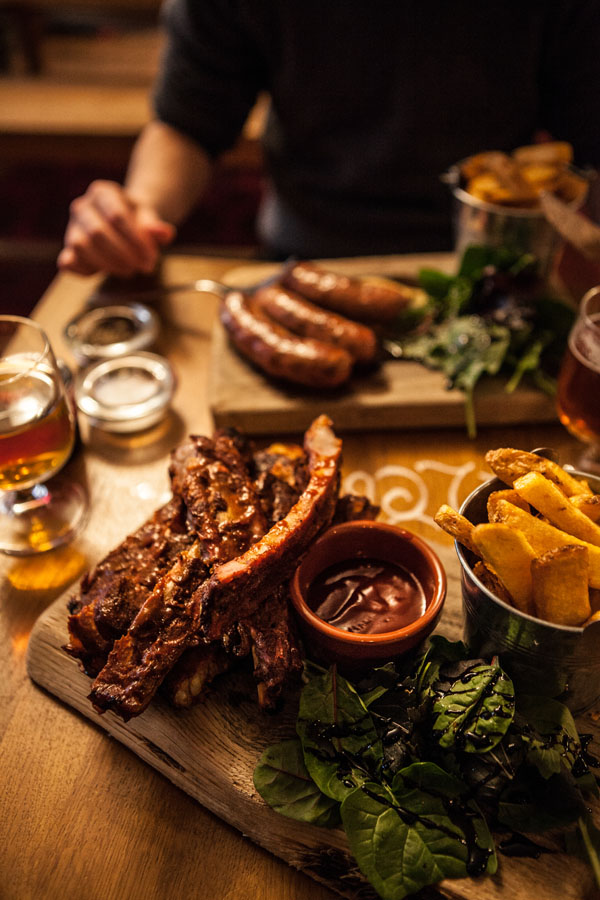 |
| Smoked ribs and bangers at The Fat Pig |
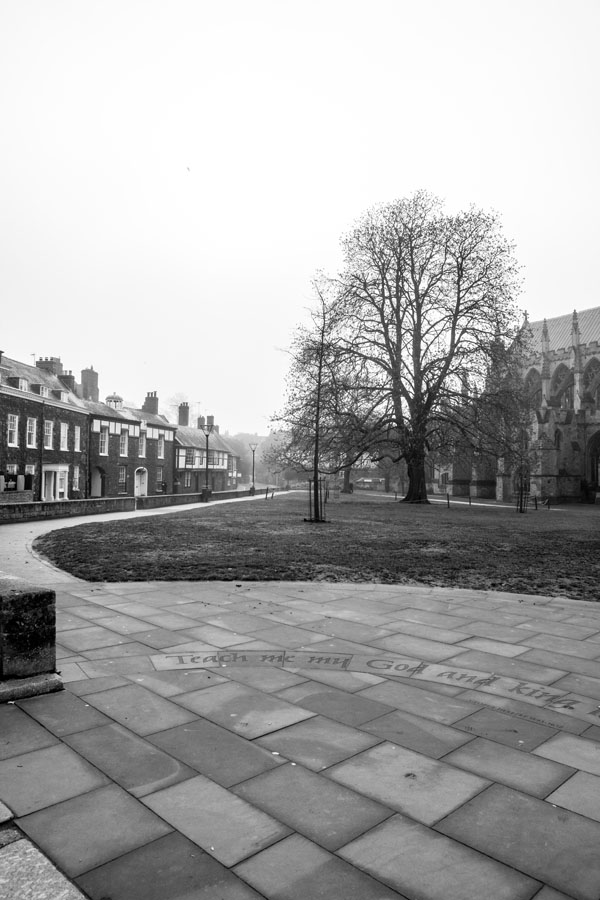 |
| A little fog on Cathedral Close |
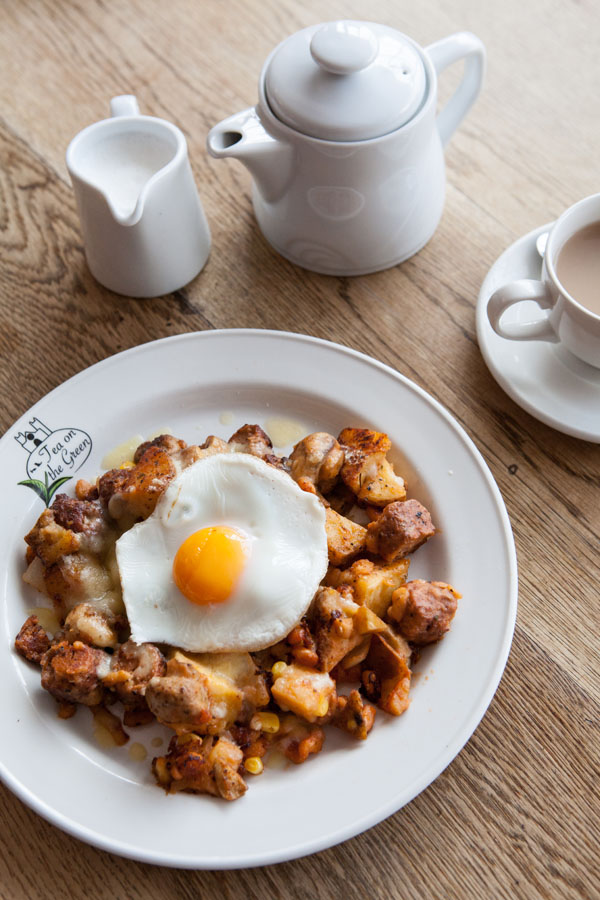 |
| Breakfast Hash on Tea on the Green – it’s a discovery, very hearty indeed |
I had spotted the owners manifesto at Tea on the Green, he advocates using only small companies and local producers. Serving tea grown in England with the homemade scones and a divers selection of luncheon and breakfast dishes. I went for the small breakfast hash which was still quite large and full of juicy local sausage chunks, crunchy spuds and cheddar, topped with a fresh hens egg. Full again we are ready for a walk around town and at noon the trip back to the station where another splendid meal on the Pullman service awaits us.
Lunch service is more relaxed with only a few tables, it is tuesday after all. I had the daily fish, which was haddock with creamed leeks and the River Exe mussels which were absolutely gorgeous. I’m a mussel woman, I love mussels but I’m also very picky when it comes to mussels. These river Exe mussels had a very solid shell, unlike any other mussel, and were a large size and very meaty. I was intrigued by them I must say, my local mussels are quite small and have a very fragile shell unlike these ones from River Exe.
We have our coffee and dessert when we arrive in Reading and by the time we enter Paddington Station in London we are again, full and happy.
Conclusion
It is lovely to get away from a busy life without a car, taking the train leaves you both with the chance of reading a book, gazing out of the window or having a nice lunch or dinner while you are driven to your destination.
Would I do it again? Yes I would, Exeter has become a sweet little town with some good eateries and pubs; the last time I visited Exeter was with my parents on one of our trips, I can remember us being refused to enter a pub because I was a little girl. The town has transformed for the better with a mixture of independent shops and chains.
I would probably travel after april as there is a bus running across the Moors from may. That way you can go further without needing transport.
Practical
Getting to Dartmoor and Exeter without a car:
Take the train from Paddington station, it takes you to Exeter in just over two hours
The First Great Western Pullman lunch and dinner service requires a booking in advance if you don’t want to be disappointed
The bus to Moretonhampstead leaves from the main bus station in Exeter and runs every two hours, you can find the time table here
Where to stay
Moretonhampstead
Great Sloncombe farm B&B – a 20 minute walk from Moretonhampstead High street
They offer bike hire and when the weather is fine they can provide a BBQ and the option of buying some of their delicious meat. The rooms are traditional and comfortable
Other B&B’s: There are a few others in the village of Moretonhampstead, look here on the village website to find them
Exeter
The Royal Clarence hotel (Abode) with restaurant of Michael Caine (who we bumped into) The rooms are modern and comfortable
Walking
Walking Dartmoor with a local: Inga from ‘Dartmoor walks this way’ was amazing, highly recommended made to measure walks. She also does bike tours with electric bikes. Email her with your questions. If you’re lucky she will bring you cake!
Walking to North Bovey, in Moretonhampstead, turn in Pound Street and follow the signs
Plenty of walks and bike tours start at Moretonhampstead, that’s why the village is an ideal base. There’s a tourist information center where you can purchase maps and such.
Where to eat and drink
Dartmoor
The White Heart (Moretonhampstead): great food and local ales, good value
The White Horse (Moretonhampstead): Locals tell us they serve excellent pizza
The Gateway Tearooms (Moretonhampstead): essential Devon cream tea
The Union Inn (Moretonhampstead): pub with beer garden and local ales
The Ring of Bells (North Bovey): Pub with pleasant beer garden, local ales and pub food
Where to eat and drink
Exeter
The Fat Pig – 2 St John Street: pub, brewery and smokehouse: Great smoked meats and hand cut chips, home brewed beers and other craft ales
The Rusty Bike – 67 Howell Road: Pub from the same owners as The Fat Pig
The Real Food Store – 11 Paris street: Organic shop with cafe upstairs
Tea On the Green – Cathedral Close: Tearoom serving excellent scones, hearty breakfasts and lunches with local produce
Shops for food
The local butchers at Moretonhampstead, sell local cheeses, pork pies, meats and some other foodie delights
The Real Food Store – 11 Paris street, Exeter: Organic shop with cafe upstairs. Serving local food and baking decent bread daily
Pipers Farm Butchers – Magdalene road Exeter
Gibson’s Plaice Fish monger – Magdalene road Exeter
Infinity foods – 25 North Road Exeter
Other shops
Haberdashery: Otton’s – 111 Fore Street Exeter
Vintage clothing: divers shops also on Fore Street Exeter
Gifts: Magdalene street has plenty of gift shops
*Everything on this trip was bought and payed for by me except the train tickets who were a kind gift from First Great Western Railways. My views are my own.*
The post A weekend away in Britain: Dartmoor and Exeter by train appeared first on Miss Foodwise.
]]>The post Cornish Splits, some very exciting news and a thank-you appeared first on Miss Foodwise.
]]>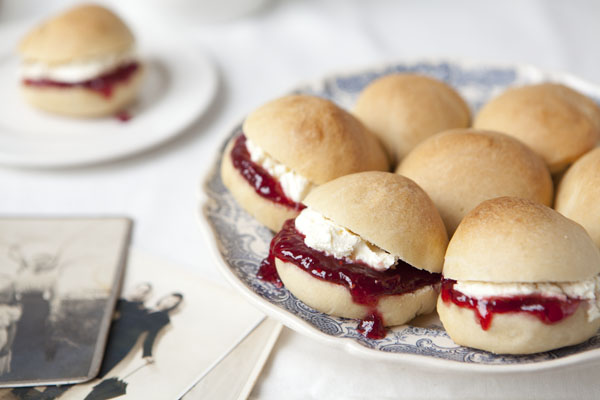
In Cornwall, a cream tea was traditionally served with ‘Cornish Splits’ rather than scones. Cornish splits are little yeast-leavened bread rolls, they are split when still warm and first buttered, then spread with jam before topping it with a generous dollop of clotted cream. Sometimes Treacle would be used instead of jam, this combination goes by the name of a ‘Thunder and lightning’ and although I’m not a big fan of treacle straight from the tin, it tasted -and the name sounded- rather good!
The splits are only baked for a short while and when removed from the hot oven, the little warm splits are then piled up in a tea towel, rubbed with a little butter before being covered by another tea towel so they don’t develop a crust.
I haven’t found any earlier reference to a Cornish split than the receipt in on of my favourite books ‘Good things in England‘ published in 1932 by Florence White, a delightful collection of 853 regional English recipes dating back as far as the 14th century.
With findings of evidence at Tavistock Abbey in Devon it is believed that the tradition of eating bread with cream and jam existed in the 11th century. In Devon a similar bun is served with cream and jam, going traditionally by the name of a Devon Chudleigh as noted by Florence White and Elisabeth David Chudleighs are made the same manner as the Cornish split, only smaller. Devonians however tell me that the ‘Devon split’ -as it is called now- is in fact a lighter and more luxurious white bun rather than heavy scone-like bread as the Cornish version.
The Cornish split is a rare treat these days but as they are best eaten while still a little warm from the oven, you get the best split by baking them at home.
I have another thing to share with you today, my beloved blog has been nominated for the Saveur Magazine 2013 Best Food Blog Award in the ‘Best Regional Cuisine Blog‘ category.
I am still pinching myself, to be a finalist and especially to be selected by the judges in this respected international competition is a great honor. The other four blogs that are nominated have all been blogging quite a while longer than I have and are all gorgeous.
This blog means the world to me, each post comes from a place deep in my heart. I know it sounds terribly cheesy but it is the truth. The moment I hit the publish button is still as exciting as if it was the first time – even more. In the beginning of writing my blog I was wondering ‘helloooow is anybody out there?’ now I know you are there.
A blog post doesn’t feel quite complete without the first comment from one of you and usually that first comment is from a lovely girl named Rosa.
Each comment brightens my day a little more, even if the comment is just to say ‘hi there’, it matters to me.
To know that you are out there, reading, listening and sharing my stories and yours with me is one of the greatest gifts on this earth. Your support, your time and your kindness mean more to me than I can say.
Thank you …
 Oh yes… one more thing if you like to vote for me or one of the other fabulous blogs nominated, you can do so by following this link here -> Voting ends this friday the 19th.
Oh yes… one more thing if you like to vote for me or one of the other fabulous blogs nominated, you can do so by following this link here -> Voting ends this friday the 19th.
You have to register to vote, this makes it just a fair competition but takes a minute longer. I thank you if you take that minute for me.
Lots of love
x Regula
Although
Elisabeth David doesn’t use lard in her recipe from her book English Bread and Yeast Cookery, Florence White does and I think it ads to the
taste. This recipe is somewhere in between the recipe of David and White using all milk instead of a mixture between milk and water. I also added an extra spoon of sugar to feed the yeast.
What do you need
- 14 g dried yeast (2 packs)
- 2 teaspoons of fine caster sugar
- 355 ml tepid full fat milk
- 115 g unsalted, good quality butter
- 30 g lard
- 750 g strong white flour
- 1 heaped teaspoon seasalt
Method
- Cream the yeast and the sugar in a little of the tepid milk.
- Melt the butter and the lard, when most of the butter and lard have melted take of the fire and stir until all the lumps are gone. Be careful not to let the butter and lard get too hot so it burns.
- In a large bowl combine the butter and lard with the flour, the salt and half the milk.
- Add the yeast and combine.
- Add the rest of the milk to create a dough, take it out of the bowl and onto a clean surface and knead for 10 minutes – it is important you do it for exact 10 minutes.
- Place the dough back in the bowl, cover with a clean tea towel and leave it to rise for 45 minutes – 1 hour or until the dough has doubled in size.
- Line a baking tray with baking paper or if you don’t have baking paper just grease with butter
- When the dough has doubled in size, knead it again to turn it into a long sausage.
- Divide into 40-50 g pieces so all buns have the same size
- Roll into balls and place evenly spaced on the baking tray that you have prepared
- Leave the buns to prove until they have nearly doubled in size
- Preheat your oven to 220° C and bake the buns for 20 minutes
When you remove them from the oven Florence White recommends you rub them over with some butter and then wrap them in a tea towel to cool so they don’t develop a crust.
You can keep these little buns for 4 days in an airtight container. Before use, place in a hot oven with a small container of water for 6 minutes. Then wrap in a tea towel as before.
Enjoy with clotted cream and jam, treacle, or why not go for savoury with the old school favourite egg and cress.
You might also like
A bread in 45 minutes: Soda bread >
Hot Cross buns, tis still the season >
The post Cornish Splits, some very exciting news and a thank-you appeared first on Miss Foodwise.
]]>